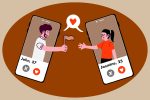By now, most of us know what dating apps are and how they work, though for many jaded daters, these apps are more of hookup apps than anything else. You set out looking for someone who could be a potential significant other, you meet a person on a dating app, you go on dates for a while, maybe end up hooking up and then boom: the person ghosts you or it turns out a hookup is what they wanted the whole time.
How familiar does this sound? Dating apps might be convenient and take some of the anxiety out of meeting someone in real life, but they cause people to be far too comfortable treating each other horribly simply because they met on an app.
There are countless dating apps out there, but let’s focus on three that have been extremely popular in recent years: Tinder, Bumble and Hinge. These each have their own set of problematic features.
Tinder
Tinder has become an app mainly for people wanting to find a hookup, but some have also found long term relationships and even marriage on it. The way Tinder works is you create a profile, make a bio and put up some pictures of yourself. Then you set your preferences of distance, age and gender. You swipe right on people you want to match with and left on people you don’t. Those whom you match with can start a conversation with you and vice versa. Sounds pretty convenient, right?
You only get to talk to your matches and hopefully someone clicks. Dating apps like Tinder, unfortunately, aren’t really for dating anymore. What was supposed to be an easier way of meeting people and connecting with them has become a device where hookup culture runs rampant. Many people are just looking for a partner for the night. Those actually seeking serious relationships and a real connection are often bitterly disappointed.
It’s not necessarily a bad thing if you’re only looking for a hookup on Tinder, but too many people are not upfront about that particular desire. In my experience and plenty of other girls’ as well, guys will make you think they’re looking for a relationship, same as you, only to ditch you if they don’t get what they want: a hookup. Or they leave as soon as you give in. Not all guys are like this, obviously, and girls surely play the same game, but it still happens far too often.
Studies show that 75% of young adults (18-24) use Tinder, and another study interviewing 500 U.S dating app users found 60% of them wanted something serious. So, if there are people on dating apps who want serious relationships, why is it so hard to find them? The reason is because there’s also such an abundance of people who don’t want anything serious, and they’re usually more forward and persistent.
The main problem with Tinder is that, yes, technically it’s a dating app, but it creates a cycle of people lying about what they want to get what they want. At this point, Tinder is a cesspool for hookup culture, so anyone looking for anything serious has little chance of being satisfied.
https://www.instagram.com/p/BxNylOankCQ/
Bumble
Bumble is a bit different from Tinder because it was created with women’s best interests in mind. You can set up a profile similar to Tinder’s profiles on Bumble, but the difference is when opposite genders match, the woman must message the guy first. The app has a code of conduct and implores its users to treat each other with respect (yeah, like that’s going to happen).
The point of Bumble is so that women can have the control when contacting men and don’t have to be plagued by annoying, way-too-forward pickup lines. Of course, some men still find ways to be inappropriate, but it’s less likely to happen than on, say, Tinder. The aim is that once a woman messages a guy first, he hopefully thinks to be respectful and actually carry on a conversation. Bumble is supposed to be more conducive to dating.
Bumble has around 40 million users worldwide compared to Tinder’s 50 million. That might partly be because Tinder was created two years prior to Bumble, but the more prominent reason could be that Bumble attracts a more passive user base. There are more men than women in general on dating apps, so the layout of Bumble might appeal more to women than men.
The issue with Bumble is that if you’re a woman and don’t like initiating a conversation at all, you won’t ever talk to anyone and the app for you would be essentially useless. If you’re not a passive woman and like taking the initiative, Bumble is more promising. Either way, there are still going to be men or people in general on this dating app that don’t want to date, only hookup. I’ve noticed guys who get bored of Tinder or want to expand their options move to Bumble, and they’re no more willing to date than before.
So, if you see Bumble as this promising dating app where all the guys want relationships, you’re sadly mistaken. Again, there’s nothing really wrong with just wanting a hookup, but statistics show a lot of women don’t want that, especially if they’re on Bumble. Therefore, many guys will lie about wanting a relationship to get the hookup they seek and all of the sudden Bumble is looking a lot like Tinder.
https://www.instagram.com/p/Bzg0QuHhWpR/
Hinge
Finally, we have Hinge, which presents itself as a dating app that is only trying to set people up on dates and establish relationships. To create a profile, you’re required to answer specific questions about yourself that will let others know what kind of person you are, such as your pet peeves, a reason you got detention, how you unwind, etc. Hinge has a more personal take on profiles so that the app is not all about looks and someone can at least somewhat gauge the type of person you are.
There’s also no swiping on Hinge. In order to match with someone, you need to like a picture or answer of theirs and send it to them with or without a comment. That way, you really think about whether you’d connect with a person rather than simply swiping yes or no countless times based on pictures. Hinge shows you who they think you’d be most compatible with as well, so there’s a better chance of finding someone to date.
While in my opinion, Hinge is the best option of these three dating apps, it is not without its problems. Sure, Hinge has much more of a dating expectation than Tinder or even Bumble. Why else go through the effort of answering Hinge’s questions if you’re not looking to date? It’s also easier to weed out people who are looking for a hookup if their answers are half-a—ed or they don’t include enough relevant information.
However, the way Hinge works is you can’t see everyone who likes you at once. You have to either accept or reject people who have liked you to see the next person, unless you pay for the upgraded version, of course. This restriction can be frustrating if you want to see everyone who’s liked you and determine who you’d be most compatible with.
Another problem with Hinge is it makes it easier to trick people into thinking they’re going to date a person when that’s actually not what the other person wants. I’ve seen people who got bored with both Tinder and Bumble appear on Hinge and, again, they’re no more willing to date anyone than on the other apps. Hinge doesn’t have a default option to put what you’re looking for like Bumble does, so even if someone is using Hinge, they might still not want anything serious.
https://www.instagram.com/p/By3u6x4lZ6x/
The Overarching Problem
So what’s the overall problem with dating apps? There’s not one simple answer. When meeting people is done from your phone and is based off what is basically a piece of paper, dating apps are convenient, but also damaging. You can’t know someone from a profile no matter how witty their bio might be.
There’s the issue of too many choices, as well. If you have an endless pool of people to pick from, when you finally find someone, who’s to say you won’t be wondering if you could’ve swiped right on someone better? Dating apps have the tendency to blind you from seeing a good match and thinking the grass is greener if you just stayed on the app.
Meeting a complete stranger outside of your social network on a dating app erases their accountability. A person is more likely to exhibit bad behavior and treat you badly if there’s no repercussions for them. There’s no mutual friend they’ll need to answer to or future event they might see you at.
It’s difficult to find out someone’s true colors with no connections or friend’s opinion to rely on. Your only option is to hope the person you’re seeing will behave right and respectfully towards you, but if they don’t, all you can do is complain to your friends who don’t even know them and move on.
The vicious cycle of people treating each other badly on dating apps is one most of us who have used them are familiar with. People ghosting, lying, only wanting a hookup but lying about it, etc. are all givens on any app you use. Now, I’m not saying that all dating apps are awful and to delete them right now. It just pays off to be mindful and watch out for bad patterns of behavior. If you want someone to date and potentially start a serious relationship with, be upfront about it and ask them to do the same. If you only want a hookup, the same rule applies.
No matter who you are, if you’re on a dating app, you deserve respect and shouldn’t settle for anything less. If someone repeatedly behaves badly and you notice a pattern, that person probably isn’t for you. Psychiatrist Dr. Amir Levine says that if you’re looking for dating prospects, look for people who fulfill CARRP. It’s an acronym that stands for consistent, available, reliable, responsive and predictable. If you’re a jaded dater that’s sick of dating apps altogether but too busy or anxious to get rid of them, start looking for CARRP in potential dates and you might find you have better luck.
















